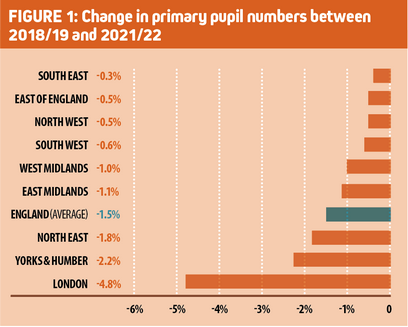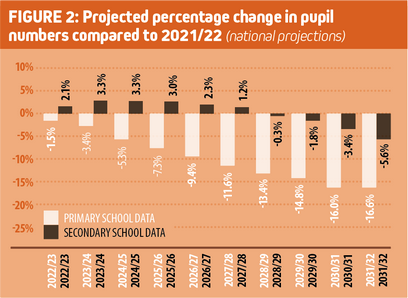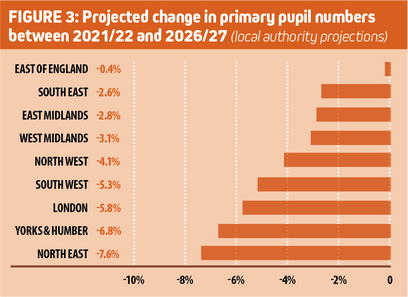Research Director Jenna Julius shares the latest data on the impact of falling primary numbers on schools.
The baby boom of the early 2000s created a large demographic bulge in the number of pupils in English state schools. Over the last 15 years this has meant that school leaders have been focused on increasing places and growing capacity.
However, the picture for the next decade is very different. A steady decline in pupil numbers is projected, which will be felt first in the primary phase before flowing through to the secondary phase. In this article, we explore what the latest data tells us about how different parts of the system are set to be affected and what the implications for schools are likely to be.
Primary schools are already experiencing a decline in pupil numbers
The number of pupils in state-funded primary schools has declined by approximately 70,000 pupils (or 1.5%) since its peak in 2018/19 (tinyurl.com/4w2mwdz2). As shown in Figure 1, primary schools in London have seen by far the sharpest decline at 4.8% between 2018/19 and 2021/22, followed by Yorkshire and the Humber (2.2%) and the North East (1.8%).

Primary pupil numbers are projected to continue to fall rapidly
Every July, the Department for Education (DfE) publishes projections (tinyurl.com/37mzt9zz) for how pupil numbers are likely to change over the following decade (the further into the future it is, the more uncertain the projection). Figure 2 shows that the number of pupils in state-funded primaries is set to continue to fall steadily over the next decade, with numbers set to fall by almost a fifth (16.6%) by 2032.

Secondary pupil numbers are set to peak in the next three years before starting to decline
In contrast, Figure 2 shows that pupil numbers in secondary schools are set to continue to rise until 2023/24 and then remain stable until 2025/26. With many secondary schools currently working to overcome the complex challenges that increased demand for places presents, demographic decline may feel like a distant issue. Nevertheless, within the next five years, pupil numbers in secondaries will start to fall from their peak, with pupil numbers set to fall by 5.6% by 2031/32 as the decline in primary numbers feeds through to secondaries.
The North East is set to experience the sharpest relative decline in primary pupil numbers over the coming years.
The national pupil projections are not disaggregated at a regional level. However, we can use the pupil forecasts made by local authorities (LAs) in 2022 to establish how different areas of the country are likely to be most affected by anticipated declines in primary pupils. It is important to note that due to methodological differences, LA projections are not directly comparable to the national projections (the former are less pessimistic about the scale of decline as they are less up to date). Figure 3 presents the projected change in primary pupil numbers between 2021/22 and 2026/27 by region, based on LA projections. It highlights that the impacts of the anticipated demographic decline will be experienced unevenly. The North East (7.6%), Yorkshire and the Humber (6.8%) and London (5.8%) are set to see the sharpest falls in relative pupil numbers between now and 2026/27. Conversely, the East of England is set to be relatively unaffected, with a projected decline of less than 0.5%. Differences are even starker at local level. For example, inner London authorities anticipate a decline (8.6%) that is almost twice as rapid as outer London authorities (4.4%).

Falling pupil numbers have far-reaching implications
The scale of the anticipated decline in pupil numbers will have profound implications for both the school system and wider society. While there is already capacity for 10% more pupils than primary schools currently accommodate nationally (tinyurl.com/4u45fyya), it is inevitable that some schools will need to reduce their intakes or close altogether. With LAs in 2022 nationally planning to create far more new primary places in the three years from 2021/22 than they remove (tinyurl.com/328hsa5j), many of the difficult decisions about which schools will have to close or see a reduction in their rolls are still to be made.
The impact is likely to affect schools differently. While oversubscribed schools will largely be sheltered from the impact of the decline in pupil numbers, it is only likely to exacerbate funding challenges for less subscribed primary schools. While small changes in pupil numbers do not typically affect a school’s fixed costs (as school staffing needs are typically unaffected by small changes in pupil numbers), they will reduce school budgets, which are heavily based on pupil numbers. This risks putting particular pressure on schools at a time when many school budgets are already stretched.
Falling pupil numbers will also lead to greater competition for pupils between schools. Given the important role that Ofsted plays in parental choice (tinyurl.com/2us6ppjv), this will also only raise the stakes of inspections and make the job of turning around an ‘under-performing’ school even harder.
Fewer pupils will also mean fewer teacher vacancies to fill, which may help reduce current teacher retention challenges (tinyurl.com/yy4usvpa). Having said that, this will not solve the teacher supply problem in the long run, as declining pupil numbers will also lead to a smaller pool of graduates who want to become teachers in the future.
What should school leaders and policymakers be doing to prepare?
While the impacts of declining pupil numbers will not affect all schools equally – if they are not already – school leaders should be seriously considering the implications on their settings and where possible take the steps necessary to mitigate the risk of undesirable impacts on their pupils and communities. Secondary school leaders in particular will need to ensure that they are prepared to rapidly transition their settings from demographic boom to decline.
It is also crucial that policymakers plan for the complex system-level change that will be needed to accommodate the anticipated decline in pupil numbers. This includes ensuring that there is greater alignment between responsibilities and powers for place planning within the school system.
Jenna Julius
Research Director at the National Foundation for Educational Research (NFER)
@JuliusJenna